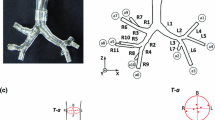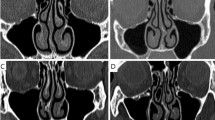Pressure–flow relationships measured in human plastinated specimen of both nasal cavities and maxillary sinuses were compared to those obtained by numerical airflow simulations in a numerical three-dimensional reconstruction issued from CT scans of the plastinated specimen. For experiments, flow rates up to 1500 ml/s were tested using three different gases: HeO2, Air, and SF6. Numerical inspiratory airflow simulations were performed for flow rates up to 353 ml/s in both the nostrils using a finite-volume-based method under steady-state conditions with CFD software using a laminar model. The good agreement between measured and numerically computed total pressure drops observed up to a flow rate of 250 ml/s is an important step to validate the ability of CFD software to describe flow in a physiologically realistic binasal model. The major total pressure drop was localized in the nasal valve region. Airflow was found to be predominant in the inferior median part of nasal cavities. Two main vortices were observed downstream from the nasal valve and toward the olfactory region. In the future, CFD software will be a useful tool for the clinician by providing a better understanding of the complexity of three-dimensional breathing flow in the nasal cavities allowing more appropriate management of the patient's symptoms.










Similar content being viewed by others
References
Bridger, G. P., and D. F. Proctor. Maximum nasal inspiratory flow and nasal resistance. Ann. Otol. Rhinol. Laryngol. 79:481–488, 1970.
Castro, F., P. Castro, A. Delgado, C. Méndez, and C. Cenjor. Computational fluid dynamics simulations of the airflow in the human nasal cavity. In: Proceedings of the 7th International Symposium on Fluid Control, Measurement and Visualization, 2003.
Durand, M. Réalisation et validation d’un modèle plastiné des cavités nasosinusiennes pour l’étude de la diffusion des aérosols. Saint-Étienne: DEA de Génie Biologique et Médical, 1999.
Durand, M., P. Rusch, D. Granjon, G. Chantrel, J. M. Prades, F. Dubois, D. Esteve, J. F. Pouget, and C. Martin. Preliminary study of the deposition of aerosol in the maxillary sinuses using a plastinated model. J. Aerosol. Med. 14:83–93, 2001.
Elad, D., R. Liebenthal, B. L. Wenig, and S. Einav. Analysis of air flow patterns in the human nose. Med. Biol. Eng. Comput. 31:585–592, 1993.
Fodil, R., L. Brugel-Ribere, C. Croce, G. Sbirlea-Apiou, C. Larger, J. F. Papon, C. Delclaux, A. Coste, D. Isabey, and B. Louis. Inspiratory flow in the nose: A model coupling flow and vasoerectile tissue distensibility. J. Appl. Physiol. 98:288–295, 2005.
Girardin, M., E. Bilgen, and P. Arbour. Experimental study of velocity fields in a human nasal fossa by laser anemometry. Ann. Otol. Rhinol. Laryngol. 92:231–236, 1983.
Hahn, I., P. W. Scherer, and M. M. Mozell. Velocity profiles measured for airflow through a large-scale model of the human nasal cavity. J. Appl. Physiol. 75:2273–2287, 1993.
Hilberg, O., and O. F. Pedersen. Acoustic rhinometry: Influence of paranasal sinuses. J. Appl. Physiol. 80:1589–1594, 1996.
Hirschberg, A., R. Roithmann, S. Parikh, H. Miljeteig, and P. Cole. The airflow resistance profile of healthy nasal cavities. Rhinology 33:10–13, 1995.
Hopkins, L. M., J. T. Kelly, A. S. Wexler, and A. K. Prasad. Particle image velocimetry measurements in complex geometries. Exp. Fluids 29:91–95, 2000.
Hörschler, I., M. Meinke, and W. Schröder. Numerical simulation of the flow field in a model of the nasal cavity. Comput. Fluids 32:39–45, 2003.
Jones, N. The nose and paranasal sinuses physiology and anatomy. Adv. Drug Deliv. Rev. 51:5–19, 2001.
Kelly, J. T., A. K. Prasad, and A. S. Wexler. Detailed flow patterns in the nasal cavity. J. Appl. Physiol. 89:323–337, 2000.
Keyhani, K., P. W. Scherer, and M. M. Mozell. Numerical simulation of airflow in the human nasal cavity. J. Biomech. Eng. 117:429–441, 1995.
Lindemann, J., T. Keck, K. M. Wiesmiller, G. Rettinger, H. J. Brambs, and D. Pless. Numerical simulation of intranasal air flow and temperature after resection of the turbinates. Rhinology 43:24–28, 2005.
Louis, B., R. Fodil, S. Jaber, J. Pigeot, P.-H. Jarreau, F. Lofaso, and D. Isabey. Dual assessment of airway area profile and respiratory input impedance from a single transient wave. J. Appl. Physiol. 90:630–637, 2001.
Louis, B., G. Glass, B. Kresen, and J. Fredberg. Airway area by acoustic reflection: the two-microphone method. J. Biomech. Eng. 115:278–285, 1993.
Naftali, S., M. Rosenfeld, M. Wolf, and D. Elad. The air-conditioning capacity of the human nose. Ann. Biomed. Eng. 33:545–553, 2005.
Papon, J. F., L. Brugel-Ribere, R. Fodil, C. Croce, C. Larger, M. Rugina, A. Coste, D. Isabey, F. Zerah-Lancner, and B. Louis. Nasal wall compliance in vasomotor rhinitis. J. Appl. Physiol. doi:10.1152/japplphysiol.00575.2005, 2005.
Park, K. I., C. Brücker, and W. Limberg. Experimental study of velocity fields in a model of human nasal cavity by DPIV. Laser anemometry, advances and applications. In: Proceeding of the 7th International Conference, Germany, September 8–11, 1997.
Proctor, D. F. Physiology of the upper airway. In: Handbook of Physiology. Respiration I, edited by W. O. Fenn and H. Rahn. Washington, DC: American Physiological Society, 1964, pp. 309–345.
Proctor, D. F. Airborne disease and the upper respiratory tract. Bacteriol. Rev. 30:498–513, 1966.
Proctor, D. F. The upper airways. I. Nasal physiology and defense of the lungs. Am. Rev. Respir. Dis. 115:97–129, 1977.
Schreck, S., K. J. Sullivan, C. M. Ho, and H. K. Chang. Correlations between flow resistance and geometry in a model of the human nose. J. Appl. Physiol. 75:1767–1775, 1993.
Simmen, D., J. L. Scherrer, K. Moe, and B. Heinz. A dynamic and direct visualization model for the study of nasal airflow. Arch. Otolaryngol. Head Neck Surg. 125:1015–1021, 1999.
Subramaniam, R. P., R. B. Richardson, K. T. Morgan, J. S. Kimbell, and R. A. Guilmette. Computational fluid dynamics simulations of inspiratory airflow in the human nose and nasopharynx. Inhal. Toxicol. 10:91–120, 1998.
Sullivan, K. J., and H. K. Chang. Steady and oscillatory transnasal pressure–flow relationships in healthy adults. J. Appl. Physiol. 71:983–992, 1991.
von Hagens, G., K. Tiedemann, and W. Kriz. The current potential of plastination. Anat. Embryol. (Berl.) 175:411–421, 1987.
Weinhold, I., and G. Mlynski. Numerical simulation of airflow in the human nose. Eur. Arch. Otorhinolaryngol. 261:452–455, 2004.
ACKNOWLEDGMENTS
This study was part of a collaborative project entitled R-MOD and supported by grants from Air Liquide and the French Ministry of Research.
Author information
Authors and Affiliations
Corresponding author
Rights and permissions
About this article
Cite this article
Croce, C., Fodil, R., Durand, M. et al. In Vitro Experiments and Numerical Simulations of Airflow in Realistic Nasal Airway Geometry. Ann Biomed Eng 34, 997–1007 (2006). https://doi.org/10.1007/s10439-006-9094-8
Received:
Accepted:
Published:
Issue Date:
DOI: https://doi.org/10.1007/s10439-006-9094-8




